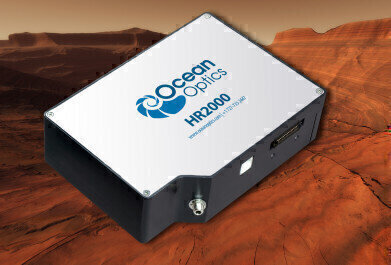Environmental Laboratory
Ocean Optics Spectrometers Head to Mars
Jan 31 2012
Three Ocean Optics (Netherlands) instruments have begun their eight month journey to Mars. Customised HR2000 spectrometers are a part of the ChemCam unit on NASA’s Mars Science Lab rover, Curiosity, launched November 26, 2011 from Cape Canaveral, Florida.
Ocean Optics supplied three modular HR2000 high-resolution miniature fibre optic spectrometers that were configured for analysis of Martian rock and soil composition using Laser Induced Breakdown Spectroscopy (LIBS). A laser mounted to the mast unit of the ChemCam instrument can fire at targets up to nine meters away, generating a series of laser pulses, the light from which is collected for the LIBS analysis.
The modular design of the HR2000, with selectable optical bench options such as detector, grating and entrance aperture (slit), made it an ideal choice for the mission. Each ChemCam spectrometer is configured to detect elemental signatures over a different wavelength of light: 240-336 nm, 380-470 nm, and 470-850 nm. The use of the three spectrometers simplifies the design and creates redundancy, as many elements under study have spectral lines in more than one of the spectral ranges covered by the three units.
Another reason the HR2000 was chosen for this mission was its reliability – a must for remote space operation where maintenance is impossible. Because the spectrometer contains no moving parts to fail, it can withstand the G forces associated with space travel. Additionally, the spectrometers were modified to handle extreme temperature ranges, radiation, shock and vibration.
The Curiosity Rover has been described by NASA as having the most advanced scientific instrumentation ever used to study the surface of Mars. With the analysis enabled by Ocean Optics’ equipment, sample analysis is exponentially faster. On prior missions, the time required to determine composition of a single sample was two to three days; ChemCam’s output is anticipated to be one dozen compositional measurements per day.
This is not the first space voyage for Ocean Optics equipment. In 2009, the company also collaborated on the ALICE spectrometer, which was instrumental in detecting the presence of water ice on the moon. Other NASA researchers have utilized Ocean Optics spectrometers for applications both on Earth and in space.
Digital Edition
IET 34.2 March 2024
April 2024
Gas Detection - Biogas batch fermentation system for laboratory use with automatic gas analysis in real time Water/Wastewater - Upcycling sensors for sustainable nature management - Prist...
View all digital editions
Events
May 06 2024 Minneapolis, MN, USA
May 13 2024 Munich, Germany
May 15 2024 Lund, Sweden
May 15 2024 Frankurt-am-Main, Germany
May 20 2024 Columbus, OH, USA


















